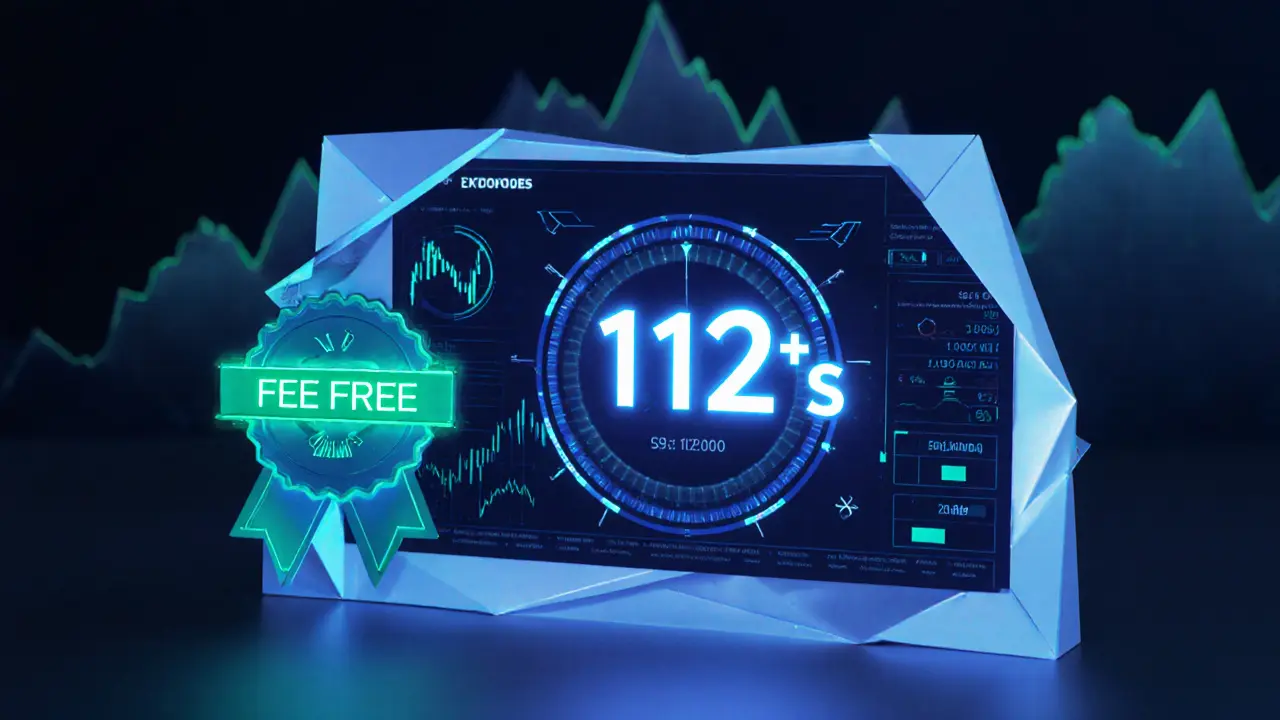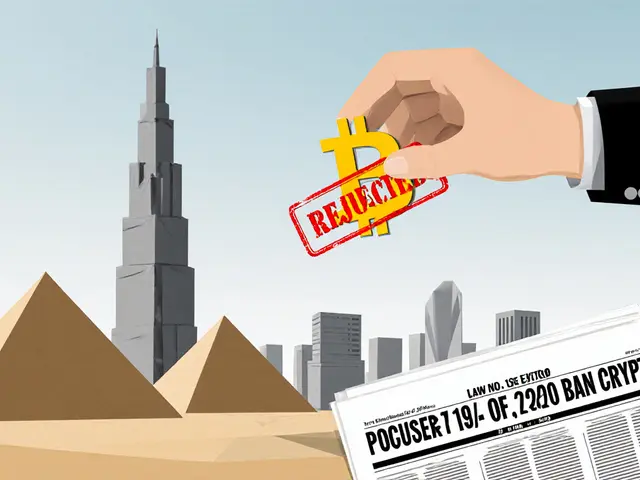One Trading Fee Calculator
Estimated Annual Savings
With One Trading's fee-free model versus traditional exchanges:
Traditional Exchange
Total Fees: $0.00
Annual Cost: $0.00
One Trading
Total Fees: $0.00
Annual Cost: $0.00
When a new crypto platform touts a trading speed of just 112 microseconds, the headline grabs attention, but the real question is whether that speed translates into a better experience for you. This review breaks down One Trading’s ultra‑low latency claim, its commission‑free model, security posture, and how it measures up against the big players you may already know.
Quick Takeaways
- One Trading promises 112µs order execution, faster than many traditional markets.
- Trading is advertised as completely fee‑free, which can save high‑volume traders thousands per year.
- Security and regulatory details are sparse, so extra caution is warranted.
- Best suited for algorithmic or high‑frequency traders who need split‑second fills.
- Casual traders may prefer established exchanges with stronger custodial safeguards.
What Is One Trading?
One Trading is a cryptocurrency exchange that markets itself as the fastest trading venue in the market. The company describes its platform as built around "speed‑optimization technology" that trims latency to an average end‑to‑end execution time of 112 microseconds, a figure it claims beats even some legacy financial markets operating at 126 microseconds.
Beyond speed, One Trading positions itself as a commission‑free service. In a landscape where most centralized exchanges charge between 0.1% and 1% per trade, a zero‑fee model is an eye‑catching differentiator, especially for traders who execute dozens of trades per day.
Ultra‑Low Latency: How Fast Is 112Microseconds?
Microseconds are a millionth of a second. In high‑frequency trading (HFT), the difference between a 150µs and a 100µs execution can be the margin between profit and loss. One Trading achieves its speed by colocating servers near major exchange match engines, using custom networking stacks, and stripping away every unnecessary software layer.
For context, most major crypto exchanges such as Binance or Kraken report average latency in the range of 5-10milliseconds (5,000-10,000µs). While real‑world network conditions can add jitter, One Trading’s infrastructure promises an order‑of‑magnitude advantage. If you run a bot that trades on micro‑price movements, that edge could be valuable.
Fee‑Free Trading: A Double‑Edged Sword
Trading without commissions sounds like a win‑win, but the model raises two practical concerns:
- Hidden costs - Exchanges often recoup revenue through spread widening, withdrawal fees, or premium services like margin lending. One Trading’s public documentation does not disclose any spread markup, so traders should monitor order‑book depth to ensure pricing remains competitive.
- Sustainability - Running an ultra‑low latency infrastructure is expensive. Without a clear revenue stream, the platform may rely on liquidity rebates, data sales, or future premium features. That uncertainty could affect long‑term reliability.
For high‑volume market makers, eliminating the 0.2%‑0.5% typical maker‑taker fees could translate into substantial savings. For occasional traders, the benefit is less dramatic but still a nice perk.

Security and Regulatory Landscape
One Trading’s public information does not detail its security architecture. Most established exchanges employ a blend of:
- Multi‑factor authentication (MFA) for login and withdrawals
- Cold storage for the majority of user funds
- Withdrawal whitelists and IP restrictions
Because One Trading’s site does not explicitly list these measures, users should assume a higher risk profile. Until the platform publishes audit reports or regulatory licenses, it remains a gray area.
Regulatory compliance is another unknown. Major exchanges typically hold licences in jurisdictions like Malta, the EU, or the US, which dictate KYC/AML procedures and provide a legal framework for user protection. Without clear licensing information, One Trading may be limited to jurisdictions with lighter oversight, potentially restricting access for users in heavily regulated markets.
One Trading vs. the Big Boys: A Comparative Snapshot
| Feature | One Trading | Binance | Coinbase | Kraken |
|---|---|---|---|---|
| Average Execution Latency | ~112µs | 5-10ms | 5-12ms | 6-12ms |
| Trading Fees | Commission‑free (no maker/taker) | 0.10%-0.20% maker, 0.10%-0.25% taker | 0.50%-1.50% (varies by volume) | 0.00%-0.26% maker, 0.10%-0.26% taker |
| Supported Assets | Limited (exact list undisclosed) | 500+ crypto pairs | 200+ crypto pairs | 150+ crypto pairs |
| Security Features | Not publicly detailed | MFA, cold storage, insurance fund | MFA, cold storage, FDIC‑insured USD wallets | MFA, cold storage, 2‑factor withdrawal limits |
| Regulatory Licences | Unclear / not disclosed | Multiple global licences (Malta, Singapore) | US Money Transmitter, EU, UK licences | EU, US, JPY licences |
| API Access for Algo Trading | Available (speed‑optimized) | REST & WebSocket APIs | REST & WebSocket APIs | REST & WebSocket APIs |
The table makes clear that One Trading excels in raw speed and fee structure, but trails in asset variety, documented security, and regulatory transparency. If those latter factors matter to your trading style, a hybrid approach-using One Trading for latency‑critical strategies and a mainstream exchange for broader diversification-might be the sweet spot.
Who Should Consider One Trading?
Algorithmic and high‑frequency traders will find the 112µs execution time compelling. Strategies that hinge on sub‑millisecond arbitrage, market‑making, or rapid order‑book placement can benefit from the reduced slippage.
High‑volume market makers who need to keep fees low may also appreciate the commission‑free model, provided they verify that spreads remain tight.
Conversely, retail investors looking for a simple buy‑and‑hold experience, extensive coin selection, or strong custodial guarantees should probably stick with established platforms until One Trading publishes more comprehensive security and regulatory information.
Getting Started on One Trading
- Visit the official One Trading website and click the “Sign Up” button.
- Enter your email address, create a strong password, and confirm the verification code sent to your inbox.
- Complete the KYC flow: upload a government‑issued ID, a selfie, and proof of residence. While the platform’s exact requirements aren’t public, most exchanges ask for similar documentation.
- Enable multi‑factor authentication (preferably an authenticator app) to harden your account.
- Deposit crypto via the supported wallet address (usually a unique deposit address per currency). Note that fiat on‑ramps are not prominently advertised, so you may need to transfer crypto from another exchange.
- Familiarize yourself with the UI: the order book, market depth chart, and the “Speed Optimizer” panel that displays real‑time latency metrics.
- If you run bots, generate an API key from the “API Management” page. The API is advertised as low‑latency, supporting both REST and WebSocket endpoints.
- Test with a tiny order to verify execution speed and confirm that the spread aligns with market rates before scaling up.
Because the platform’s public documentation is limited, keep an eye on the support portal for any updates on deposit methods, withdrawal limits, or new asset listings.
Pros and Cons Checklist
- Pros:
- 112µs average execution - among the fastest in crypto.
- Zero commission on trades - reduces cost for high‑volume activity.
- API optimized for algorithmic trading.
- Cons:
- Lack of publicly verified security measures.
- Regulatory status unclear - may limit access in some regions.
- Limited public information on supported cryptocurrencies.
- Potential hidden costs via spreads or premium services.

Frequently Asked Questions
Is One Trading really fee‑free?
Yes, the platform advertises zero maker and taker fees. However, users should monitor the spread, as a wider spread can indirectly increase trading costs.
How does the 112µs latency compare to traditional markets?
Many equity or futures markets report latencies around 120‑130µs. One Trading claims to be slightly faster, positioning it competitively for latency‑sensitive crypto strategies.
Is my money safe on One Trading?
The exchange does not publish detailed security specs or regulatory licences, so the safety level is unclear. Users should only allocate funds they can afford to lose and consider using cold storage for the majority of holdings.
Can I trade fiat on One Trading?
Current public information focuses on crypto‑to‑crypto pairs. Fiat on‑ramps are not prominently featured, so you’ll likely need to bring crypto from another exchange.
Does One Trading support mobile trading?
A mobile‑optimized web interface is available, but a dedicated iOS/Android app has not been announced as of October2025.
In a market crowded with feature‑rich exchanges, One Trading stands out for raw speed and a fee‑free model. Whether that edge outweighs the opacity around security and regulation depends on your trading style. Test the platform with small amounts, keep an eye on spread quality, and treat it as a specialized tool rather than a one‑stop shop.





Lana Idalia
Reading through the One Trading review feels like peering into the soul of modern finance, where speed becomes a virtue and fees dissolve into the ether. It's almost as if the market is whispering an existential question: are we trading assets or trading time? The platform's claim of near‑zero latency mirrors the fleeting nature of our own attention spans. Yet, beneath the glossy UI lies a deeper truth about how we value convenience over transparency. I can sense the hidden costs lurking in the shadows, even when the fee column reads "0.00". It's a seductive illusion, a digital mirage that promises freedom while subtly guiding our behavior. The absence of explicit fees forces us to confront the opportunity cost of each trade, a cost measured not in dollars but in the lost moments of contemplation. If you ask me, the real price is the surrender of agency to algorithmic speed. In this hyper‑fast world, we risk becoming drones feeding on the pulse of the blockchain. So, while the numbers look appealing, ask yourself: what are we really trading away?
Maggie Ruland
Oh sure, because nothing says "trustworthy" like a platform that advertises free fees while charging you in attention spans. If the speed was any faster, my coffee would finish brewing before the order hits the book.
Joyce Welu Johnson
I totally get why people are excited about a fee‑free model – it can really level the playing field for small traders. In practice, though, you still need to watch for hidden spreads and withdrawal costs. If you’re new, start with tiny amounts and test the order execution speed yourself. It’s also worth checking their customer support responsiveness; a fast trade isn’t much help if you can’t resolve an issue quickly. Remember to keep an eye on the liquidity depth, especially during volatile periods. Overall, One Trading can be a solid choice for hobbyists looking to avoid the usual fee grind.
Ally Woods
Honestly, I tried it once and the UI felt kind of clunky. The speed was decent but nothing blew my mind. I guess if you’re not super into day‑trading, it’s okay.
Kristen Rws
Sounds like a fresh start for traders!
Fionnbharr Davies
When we examine the architecture of One Trading, we must first acknowledge the philosophical premise that underpins any exchange: the mediation between desire and execution. The platform promises a seamless conduit, a bridge where latency approaches the theoretical minimum, thereby honoring the trader’s intent with immediacy. In doing so, it aligns with the ancient principle of *kairos*-the right moment, captured in milliseconds. Yet, the allure of a fee‑free model brings to light an ethical paradox: can any service truly be devoid of cost, or does the expense merely shift into another domain, such as data or liquidity provision? Moreover, the absence of explicit fees invites a reassessment of value, urging participants to consider opportunity costs, slippage, and the hidden price of market impact. The exchange’s interface, while sleek, must also respect cognitive ergonomics, allowing users to focus on strategy rather than navigating labyrinthine menus. From a broader economic perspective, the reduction of transactional friction can democratize access, potentially reshaping market participation patterns. However, this democratization hinges on transparent governance and robust security, lest the platform become a playground for malicious actors. It is essential, therefore, to scrutinize the underlying smart‑contract audits and the robustness of their risk‑management frameworks. The speed advantage, while impressive, must coexist with resilience against network congestion and denial‑of‑service attempts. In real‑world trading scenarios, the ability to execute orders without delay can safeguard against slippage, particularly during high‑volatility events. Yet, one should remain vigilant about the liquidity depth on order books; speed alone cannot compensate for thin markets. Ultimately, the suitability of One Trading for a given trader rests on a balance of these factors: speed, fee structure, liquidity, and governance. By weighing these dimensions, users can determine whether the platform aligns with their risk tolerance and strategic objectives. In sum, the exchange embodies a compelling experiment in lowering barriers, but its success will be measured by the durability of its ecosystem and the trust it earns from its community.
Narender Kumar
Esteemed colleagues, I must express my profound admiration for the meticulously crafted architecture which One Trading purports to possess. The declarative assertion of zero‑fee transactions, while ostensibly generous, invites a rigorous interrogation of the underlying mechanisms that facilitate such an offering. One must contemplate whether the exchange leverages ancillary revenue streams, perhaps via margin provisions or data monetisation, to contravene the null‑fee premise. I remain, however, cautiously optimistic that the platform's dedication to swift execution shall serve the discerning trader with commendable alacrity.
Anurag Sinha
Look, they’re probably hiding something. Every "free" service has a backdoor, maybe they sell your data to the Illuminati or something. The speed claim? Might just be a PR stunt. And the fees? They’ll pop up when you least expect it, like a hidden camera. I’d keep my wallet locked.
Raj Dixit
People need to stop glorifying zero‑fee platforms without understanding the hidden national interests at play. These exchanges are often tools of foreign influence, pushing their agenda under the guise of "free" trading. It’s a moral duty to boycott such services and support domestic alternatives.
Darrin Budzak
I think One Trading could be a decent option for folks who just want to dip their toes without worrying about fees. The speed seems alright and the UI is pretty clean. It’s worth giving it a shot if you’re curious.
Andrew McDonald
While the concept of a no‑fee exchange sounds appealing, one must consider the underlying economics. If there’s no direct revenue, how does the platform sustain operations? The answer likely lies in subtle mechanisms such as spread differentials, order flow payments, or premium services. 🤔
Enya Van der most
Hey team, this looks like a fantastic opportunity to level the playing field! If the speed truly lives up to the hype, it could empower so many traders who can’t afford high fees. Let’s keep the momentum going and share experiences so we all grow together!
Eugene Myazin
As someone who loves discovering new tech, I’m really intrigued by the idea of a fee‑free exchange. The cultural shift towards more inclusive finance is something I fully back. If you’ve tried it, drop your thoughts – let’s build a community around it.
karyn brown
Honestly, a free‑fee model sounds too good to be true – it's like finding a unicorn 🦄, but if it works, it could change the game! Just watch out for hidden costs, though.
Rachel Kasdin
We shouldn't let foreign platforms dictate our market standards – it's high time we support home‑grown solutions and keep our trade ecosystem sovereign.